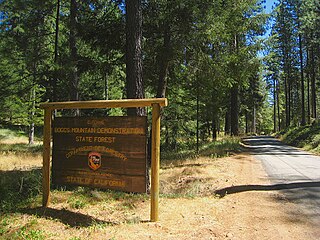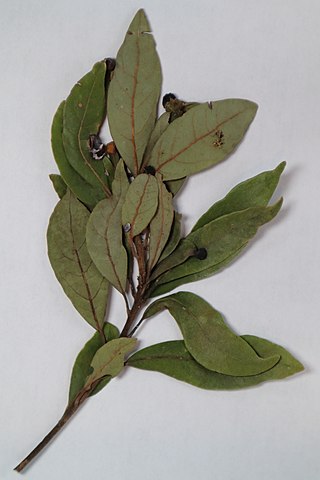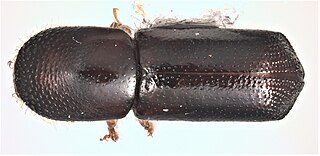
A bark beetle is the common name for the subfamily of beetles Scolytinae. Previously, this was considered a distinct family (Scolytidae), but is now understood to be a specialized clade of the "true weevil" family (Curculionidae). Although the term "bark beetle" refers to the fact that many species feed in the inner bark (phloem) layer of trees, the subfamily also has many species with other lifestyles, including some that bore into wood, feed in fruit and seeds, or tunnel into herbaceous plants. Well-known species are members of the type genus Scolytus, namely the European elm bark beetle S. multistriatus and the large elm bark beetle S. scolytus, which like the American elm bark beetle Hylurgopinus rufipes, transmit Dutch elm disease fungi (Ophiostoma). The mountain pine beetle Dendroctonus ponderosae, southern pine beetle Dendroctonus frontalis, and their near relatives are major pests of conifer forests in North America. A similarly aggressive species in Europe is the spruce ips Ips typographus. A tiny bark beetle, the coffee berry borer, Hypothenemus hampei is a major pest on coffee plantations around the world.

The mountain pine beetle is a species of bark beetle native to the forests of western North America from Mexico to central British Columbia. It has a hard black exoskeleton, and measures approximately 5 millimetres, about the size of a grain of rice.

In ecology, a disturbance is a temporary change in environmental conditions that causes a pronounced change in an ecosystem. Disturbances often act quickly and with great effect, to alter the physical structure or arrangement of biotic and abiotic elements. A disturbance can also occur over a long period of time and can impact the biodiversity within an ecosystem.

The ant beetle, also known as the European red-bellied clerid, is a medium size insect, rather soft-bodied, with strong mandibles that can tear between the hard sclerotized integument of bark beetles. Larvae and adults are common predators of bark beetles in Europe.
Mating disruption (MD) is a pest management technique designed to control certain insect pests by introducing artificial stimuli that confuse the individuals and disrupt mate localization and/or courtship, thus preventing mating and blocking the reproductive cycle. It usually involves the use of synthetic sex pheromones, although other approaches, such as interfering with vibrational communication, are also being developed.

Boggs Mountain Demonstration State Forest is a state forest in Lake County, California that covers the northwest of Boggs Mountain. It was founded in 1949, and came into operation in 1950 when most of the site had been clear cut. The purpose was to demonstrate good practices in restoring and managing a forest. The state forest was open for recreational use, including camping, hiking, mountain biking etc. The 2015 Valley Fire destroyed 80% of the trees. The state forest as of 2021 was replanting saplings.

Dendroctonus is a genus of bark beetles. It includes several species notorious for destroying trees in the forests of North America. The genus has a symbiotic relationship with many different yeasts, particularly those in the genera Candida and Pichia that aid in digestion and pheromone production.

Laurel wilt, also called laurel wilt disease, is a vascular disease that is caused by the fungus Raffaelea lauricola, which is transmitted by the invasive redbay ambrosia beetle, Xyleborus glabratus. The disease affects and kills members of the laurel family. The avocado is perhaps the most commercially valuable plant affected by laurel wilt.

Xyleborus glabratus, the redbay ambrosia beetle, is a type of ambrosia beetle invasive in the United States. It has been documented as the primary vector of Raffaelea lauricola, the fungus that causes laurel wilt, a disease that can kill several North American tree species in the family Lauraceae, including redbay, sassafras, and avocado.
Blue stain fungi is a vague term including various fungi that cause dark staining in sapwood. The staining is most often blue, but could also be grey or black. Because the grouping is based solely on symptomatics, it is not a monophyletic grouping.

Dendroctonus rufipennis, the spruce beetle, is a species of bark beetle native to British Columbia, Newfoundland and Labrador, Nova Scotia, Ontario, Quebec, Northern Manitoba, the Yukon, Colorado, Wyoming, Montana, and Maine. They are known to destroy forests of spruce trees including Engelmann, White, Sitka, and Colorado blue spruce. Adults average 4 to 7 mm in length.

The European spruce bark beetle, is a species of beetle in the weevil subfamily Scolytinae, the bark beetles, and is found from Europe to Asia Minor and some parts of Africa.

Dendroctonus frontalis, the southern pine beetle, often shortened to simply SPB, is a species of bark beetle native to the forests of the southern United States, Mexico and Central America. It has recently expanded its range to the northeastern United States, where it is considered an invasive species and has destroyed massive amounts of pine forest.

Ips is a genus of beetles in the family Curculionidae, the true weevils. They are bark beetles, members of the subfamily Scolytinae. Species are distributed throughout the Northern Hemisphere. Some are known as introduced species in Australia and Africa. Many species are pests of forest trees, especially pines and spruces. They are known commonly as engraver beetles, ips engraver beetles, and pine engravers.

Dendroctonus valens, the red turpentine beetle, is a species of bark beetle native to the forests of North America, Mexico, Guatemala and Honduras. It has been introduced to China where it has become invasive. In its native range it causes little damage, but in China it is a destructive pest and has killed more than six million pine trees.

Rhizophagus grandis is a species of predatory beetle in the family Monotomidae. R. grandis is a specialist predator on the larvae of the great spruce bark beetle, a pest of spruce trees (Picea), and is found in Eurasian forests where its prey is found.

Dendroctonus terebrans, the black turpentine beetle, is a species of bark beetle native to the eastern United States. Its larvae tunnel under the bark of pine trees, weakening and sometimes killing the trees.

Species which are not native to a forest ecosystem can act as an agent of disturbance, changing forest dynamics as they invade and spread. Invasive insects and pathogens (diseases) are introduced to the United States through international trade, and spread through means of natural and human-dispersal. Invasive insects and pathogens are a serious threat to many forests in the United States and have decimated populations of several tree species, including American chestnut, American elm, eastern hemlock, whitebark pine, and the native ash species. The loss of these tree species is typically rapid with both short and long-term impacts to the forest ecosystem.
Verbenol (2-pine-4-ol) is a group of stereoisomeric bicyclic monoterpene alcohols. These compounds have been found to be active components of insect pheromones and essential oils.
Dendroctonus adjunctus, the roundheaded pine beetle, is a species of bark beetle in the family Curculionidae found in North America. A parasite, the roundheaded pine beetle feeds on and eventually kills pine trees of several species in Guatemala, Mexico, and the Southern United States.

















